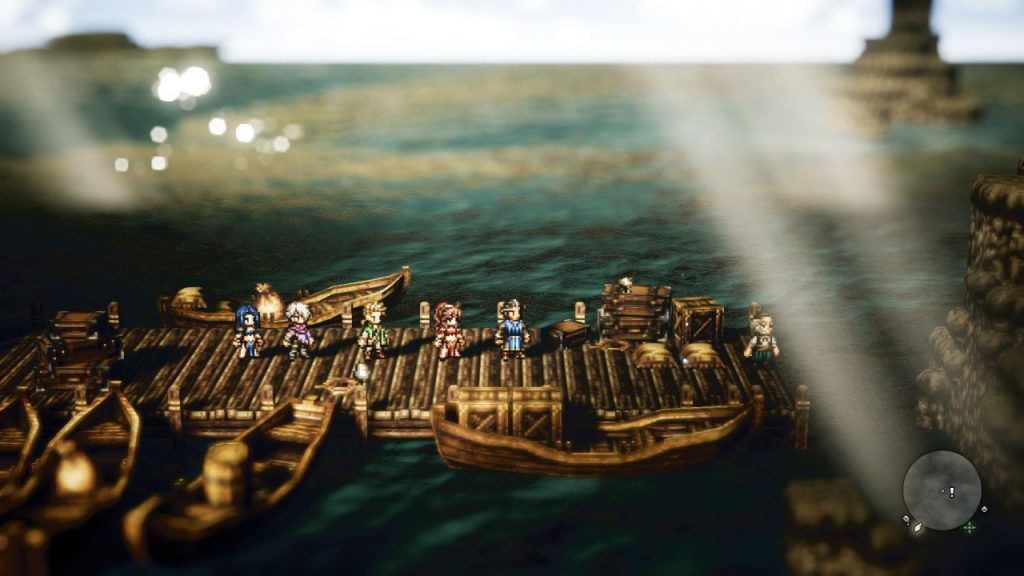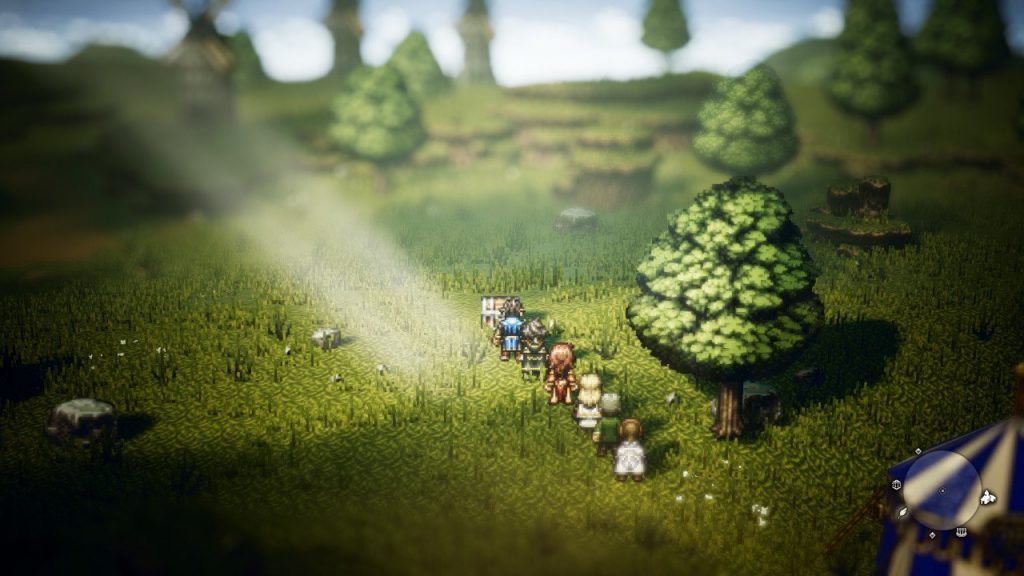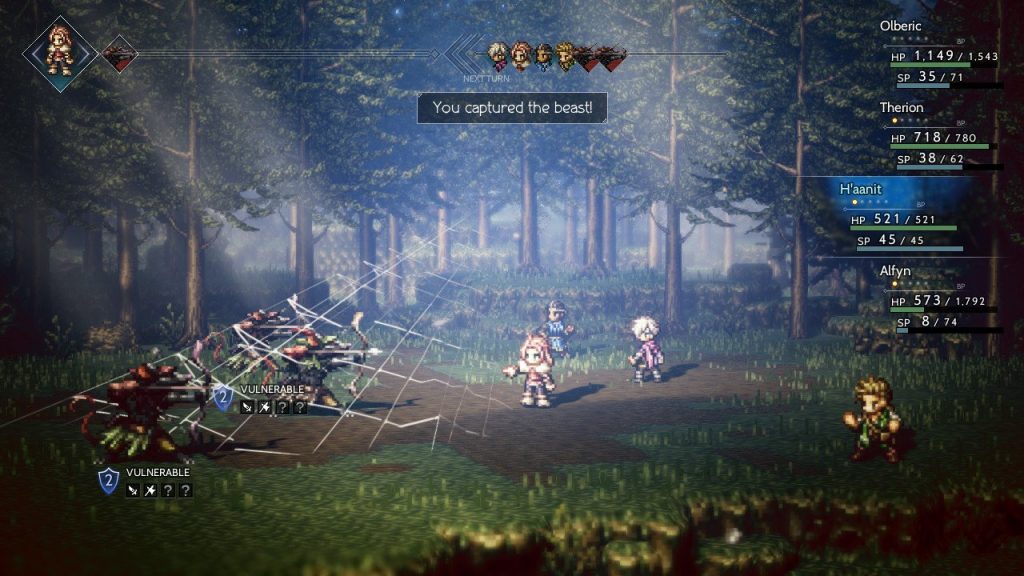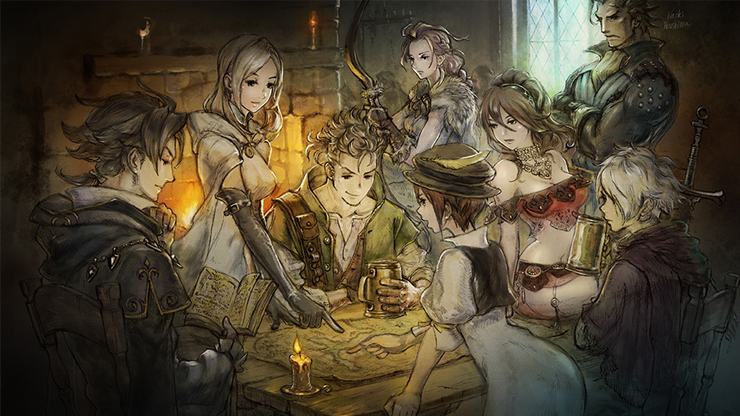July 13, 2018
While many people I know got into Final Fantasy through VII on PS1, I got into the franchise through Final Fantasy IV and V. Having looked at gameplay for the PSone games and the SNES ones, the latter drew me in more thanks to the aesthetic and the music. While I’ve now come to appreciate VII and X (this is my second favourite after IV), I’ve still been wanting to play more games that feel like the golden age Square era games. Octopath Traveler’s first demo and initial showing blew me away. It felt like I was in a timeline where Squaresoft continued to make games as fantastic as the SNES era 16-bit RPGs and built upon them. Having played the final game and basically playing it in almost every waking moment since getting my hands on it, the wait has most definitely been worth it.
Octopath is a very open and non-linear game. You begin by selecting one of the eight characters and slowly proceed to play and recruit more and go on a long journey. This bit is pretty important because the first character you select is basically a permanent party member and can never be removed from your party. I’d suggest picking someone you are comfortable with in combat or experimenting a bit before going further as you might end up with a situation where things don’t go well for you in combat. When it comes to the actual story, there are things to love and some things that are disappointing. Given the permutations possible for your party composition, cut-scenes involving story moments do not acknowledge the party members and focus on the single story character for the chapter you’re playing. There is some banter between party characters and references in some flavour text for NPCs, though, which is a nice touch. The party banter that occurs in some situations is a lovely even though it kind of feels tacked on since they don’t interact in the actual story moments.

As you start recruiting characters early on, the levels for the first chapter of the cast scale up making sure you don’t steamroll dungeons or the boss by the time you reach the 5th or 6th character to add to your group. There’s a “Danger Level” indicator before you enter a new area or a dungeon so you know what to expect in terms of enemy difficulty. Exploration is also a fantastic way to find new items and equipment in chests and even various NPCs that will help you out in side quests. Speaking of side quests, there are a ton of them and they are vague, so in a lot of cases you end up remembering or finding things required only through path actions and exploration. Exploration is also how you unlock most of the secondary jobs for the main cast through shrines in the world.
Just like Bravely Default, Octopath’s combat feels like an enhanced turn-based combat system that manages to keep things fresh dozens of hours in. Your aim is to break the enemy armour and then let rip all your attacks while they are stunned in the break state. Each enemy has different weaknesses and you need to learn the weaknesses through trial and error or a bit of common sense depending on the enemy so that you can quickly deal with the same enemies later on. You also have boost points or BP that you earn with each turn before augmenting your attacks and using up the BP to either perform multiple attacks in succession or a super powerful single attack. There’s a lovely amount of strategy at play with the decisions you need to make based on the situation at hand with the enemies. Boss battles in particular have always had me on my toes and never complacent because sometimes a single wrong skill can end up with a party wipe. Thankfully save points are plentiful and there’s a pretty good autosave system that saves whenever you move to another location. The combination of the well thought out combat system and HD Rumble makes this one of the most satisfying turn based combat systems out there. Just don’t wander into an area that’s multiple danger levels above your current average party level.

Structurally, I love how open and non linear this experience is. It satiates my sense of adventure thanks to exploration, has some great boss battles, and a load of side content and optional activities in the open world for me to experience if I want to. I was initially a bit worried about the length but in a lot of ways I feel like this game almost has too much stuff to do if you want more and can easily see myself crossing 100 hours before I’m satisfied. Xenoblade Chronicles 2 and Octopath are likely going to be staples on my Switch for a long time and I never thought I’d keep going back to these two games with the likes of Splatoon 2 and Fire Emblem Warriors also installed on my Switch.
I love trying to break JRPGs and I’ve managed some hilarious things as early as a few hours into Octopath thanks to some unlucky exploration and Primrose’s Bewildering Dance ability. Her ability can cause a random effect and this ranges from XP or Job Point boosts for a single battle to a random spell or status effect on your party or the enemies. I’ve even had her give me a strength boost for the party in one turn and then blind the party the next turn. This has been very useful to try and get an XP boost for the times I had to grind. Another fun thing that happened is I managed wandering into a high level optional dungeon and I wanted to see what was at the end so I managed fleeing from most encounters and dealing with powerful enemies just a few times before reaching what ended up being a very very hard boss that even had the game warn me before I entered battle. This fight was very long but the experience was more than worth it. I love discovering optional things like this in games.

I’ve mentioned it already but the visuals on display here are truly striking. On paper, adding modern and high definition effects and depth of field effects to a sprite based game on a 3D area should not work, but the team has somehow managed to create an aesthetic that continued to make my jaw drop each time I went into a new area. Battle animations are slick and the sprite work is stunning. I love how bosses get a much larger sprite compared to the party that takes me back to the SNES era of Square JRPGs once again. There’s a lot of depth hidden with the visuals as well, and exploration rewards you pretty greatly in dungeons and the open world. The only slight downer here is the performance because there are some random stutters while running in some locations.
While the first demo had my expectations very high for the English voice acting, the final game has a few inconsistencies. There’s a lot of unvoiced dialogue and quite a bit of dialogue with just a monosyllable sound. While this isn’t a huge deal, I expected the actual voice acting to be great but some of it is awkward. The main characters and most of their stories have great dialogue. Olberic and Therion’s voice actors deserve a special mention as I never got tired of their dialogue. Music, on the other hand, is spectacular. I was a bit concerned when an RPG that was to follow Bravely Default didn’t have the team who did that soundtrack but my fears have all been put to rest. Not only is the music here better but it is a lot more consistent. Each opening location and the neighbouring areas has some of the best location specific music ever. I’m genuinely just tempted to fast travel to certain locations to hear the music instead of continue on with the story sometimes. Battle themes are catchy and they I never got bored of them despite a few gameplay sessions where I just wasted time trying to grind something unnecessary. Speaking of battles, I’m a huge fan of how well HD Rumble has been incorporated in various little sound effects like opening and closing doors and in combat through status effects and the break mechanic. It makes the combat feel even more satisfying. Yasunori Nishiki is a name I had no idea about until this game and it is a name I won’t forget.

I’m a big fan of the side quest variety and how you’re encouraged to use path actions to solve various problems but the quests themselves are far too vague initially. There were a lot of situations where I literally had no idea how to even approach a quest and just put said quest off until much later. I was hoping for a system like Xenoblade Chronicles 2 has right now for side quests. When you level up, having the characters not in your party not earn experience is also a problem because of how the chapters and level requirements are structured. You can end up in a situation where you focus on a few characters you like including your first choice who cannot be swapped out to want to do someone else’s chapter and be essentially level gated out because one or two characters are too level to fight in a new location that has your next story path. This forces you to grind and while the fantastic combat system sort of alleviates this, I wish the backup party members also earned XP so this could be avoided. There are also a few annoyances with how equipment is handled since you can’t unequip things from standby party members unless they are made active which can only be done in an inn in a town. There’s a lot of thought put into various design decisions but it feels like some things have been left to the old school method which hasn’t ended up working out too well overall. It feels like a lot more effort was put into some aspects of the game while others were just tacked on which is slightly disappointing.
Octopath Traveler has brought to mind some of my fondest memories of games like Final Fantasy V, Final Fantasy X, Bravely Default, and even a bit of what I played of Romancing SaGa 2. I don’t mention those names lightly and while this is a fantastic JRPG in its own right, it continues to resonate more and more with me as I see how some aspects of my favourite games have been sprinkled in to this game that feels like a love letter to the 16-bit JRPG era but built for the modern era. Octopath Traveler is not only an essential RPG but it is a fantastic reason to buy a Switch if you’ve been craving a meaty JRPG with one of the best soundtracks in gaming and a superb battle system.
Gorgeous visuals and slick animations
Superlative soundtrack
Fantastic combat system
Tons of things to do and locations to explore
Side quests are far too vague
Some QOL and design issues
Octopath Traveler feels like a gem from the golden age of JRPGs that is something I've been craving with stunning visuals, music that deserves a vinyl release, and so much more.






